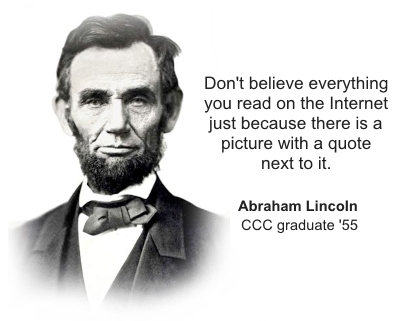4.6: Evaluating your sources
- Page ID
- 185979
What is a "good" source?
Great question. A "good" source is both credible and relevant.
Relevancy means the source helps you answer your questions, learn widely about your topic, and think about your topic in new ways.
Credibility, when applied to an information source, means trustworthy. Trustworthiness is tricky to determine. Some evaluative questions to keep in mind include:
- Is this information deliberately biased, and is the creator transparent about that bias?
- Who created it? Are they an expert? Do they need to be?
- When was it published? What is the publication, and does that publication have a good reputation?
- Why was it published: to inform, persuade, entertain, etc.?
- Does it cite its sources? Does that matter for your intended use of the information?
Ultimately it is up to you to determine — using research and your own critical judgment and The CRAP Test — whether a source is credible or not. And "credible" can mean something and look different to everyone. Your instructors expect you to use credible, authoritative information in your projects and papers, so be upfront and clear about why you trust the information your choose to use.
CCC Librarians are here to help you with this question, too. ♥
Evaluate information using the CRAP test
Evaluating information is especially important when completing projects and assignments in college (and at work!) because you will be evaluated on the quality of sources you use. The CRAP Test is a helpful tool to use when deciding if a source is "good." CRAP stands for Currency, Reliability, Authority and Purpose.
When you evaluate a source, consider these four concepts by asking yourself a few questions about each.
Currency
- When was the item originally written or created?
- How recently has the item been updated?
- Is the information current enough for your topic?
Reliability
- How important is it for you that this information is accurate?
- Are there Works Cited or References, informal citations(opens in new window), or links to outside sources? Are sources included for data, quotations, and images?
- Was the item reviewed by experts or people with relevant experience?
- Does this information have any characteristics of misinformation, disinformation, or fake news?
- Does the information seem accurate based on your existing knowledge of the subject?
Authority
- Who is the creator or author? What does it mean if you cannot identify the creator or author?
- What are their credentials? Can you find any information about the author's background, education, and/or experience?
- Who is the publisher, sponsor, or hosting website? Are they reputable? What is the publisher's interest (if any) in sharing this information? What is on their "About Us" page?
Purpose / Point of View
- Does the information help you answer your questions, learn widely about your topic, and / or think about your topic in new ways?
- Is the information fact or opinion?
- Can you identify bias in the article? Does the information amplify certain viewpoints or experiences? Does the information omit or misconstrue certain viewpoints or experiences?
- Is this information meant to educate you, persuade you, sell you something, and / or appeal to your emotions or values? If so, are these intentions clearly stated?
- Who is the intended audience for this information? How might the audience impact what is shared and how (e.g., does this resource require in-depth knowledge to understand)? Is this information intended for you and your information needs?
Optional: Pro-level CRAP Testing
If you want to dig deeper into The CRAP Test, choose a source and work through this guided CRAP Test exercise(opens in new window) (GDoc).
Image adapted from public domain photo: Wikimedia Commons
CRAP Test adapted from Beestrum, M., & Orenic, K. (2008). The CRAP Text. Available from http://commons.emich.edu

